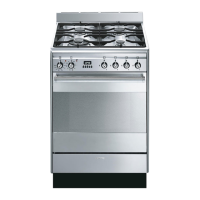
Do you have a question about the Smeg SUK61PX8 and is the answer not in the manual?
| Control type | Rotary |
|---|---|
| Product type | Freestanding cooker |
| Product color | Stainless steel |
| Built-in display | No |
| Control position | Front |
| Grill | Yes |
| Noise level | - dB |
| Number of ovens | 1 |
| Total oven power | - W |
| Oven power source | - |
| Total oven(s) interior capacity | 70 L |
| Hob type | Gas |
| Cooking zone 1 type | Small |
| Cooking zone 2 type | Medium |
| Cooking zone 3 type | Large |
| Cooking zone 1 power | 1000 W |
| Cooking zone 2 power | 1750 W |
| Cooking zone 3 power | 4000 W |
| Number of cooking zones | 4 zone(s) |
| Current | 13 A |
| Energy consumption (conventional) | 0.89 kWh |
| Energy consumption (forced convection) | 1.09 kWh |
| Customs product code (TARIC) | 8516601000 |
| Country of origin | Italy |
| Package depth | 675 mm |
| Package width | 670 mm |
| Package weight | 6780 g |
| Width | 600 mm |
|---|---|
| Height | 915 mm |
| Weight | 6050 g |
| Height (min) | 900 mm |
Details on the disposal of electrical and electronic equipment and hazardous substances.
Instructions for proper disposal of packaging and the old appliance.
Detailed explanation of the function and temperature selection knobs and programming clock.
Instructions for inserting and removing oven racks and trays using the safety lock.
Guidance on using the support rack for cooking and fat collection.
Instructions for placing reduction pan stands and WOK reduction stands.
Steps for preparing and positioning the rotisserie rod with food.
Important safety and usage advice before lighting hob burners.
Step-by-step guide for igniting the hob burners using the electronic lighter.
Tips for efficient burner use, gas consumption, and pan placement.
Table showing recommended pan diameters for each hob burner.
Instructions for initial preparation, including label removal and heating the empty oven.
Explanation of the 5 oven runners for positioning trays and racks at different heights.
Information about the oven's storage compartment and its limitations.
Description of the cooling fan system and its operation during and after cooking.
Information on when the internal oven light activates.
Essential safety and usage guidelines for oven operations, including door closure and condensation.
Instructions for setting time, timer, buzzer, and automatic/semi-automatic cooking.
Description of the ECO cooking function for low energy consumption.
Explanation of the traditional static cooking mode for various foods.
Details on using the grill element for browning and grilling meats.
Information on using the rotisserie in combination with the grill element.
How fan-assisted static cooking ensures uniform cooking on multiple levels.
Using the fan-assisted grill for perfect grilling of thick foods.
How fan-assisted bottom cooking speeds up cooking and is good for finishing.
Using the circular element and fan for multi-level cooking without mixed smells.
Turbo cooking combines fan and traditional methods for quick, efficient multi-level cooking.
General advice, tips for cooking meat, desserts, defrosting, and using grill functions.
A table detailing food types, weight, function, runner position, temperature, and time.
Recommendations for maintaining stainless steel surfaces in good condition.
How to perform daily cleaning of stainless steel surfaces using specific products.
Advice on removing food stains and residues, and avoiding damage to enamel.
Instructions for cleaning the glass lid of the cooking hob.
Detailed steps for removing and cleaning the glass lid of the hob.
Cleaning instructions for the pan stands on the cooking hob.
How to remove and clean burner caps and flame-spreader crowns.
Importance of keeping igniters and thermocouples clean for correct operation.
General advice for regular oven cleaning, including removing parts and racks.
Steps to remove oven guide frames for easier cleaning, especially after pyrolytic cycles.
How to clean the oven door glass panel without using abrasive products.
Instructions for cleaning the oven door seal to maintain its softness and shape.
Explanation of the high-temperature pyrolysis cleaning process for the oven.
Preparation steps before starting pyrolysis, including removing accessories and cleaning glass.
How to select the pyrolysis function, set duration, and use delayed start.
Step-by-step guide for replacing the oven's light bulb.
Instructions on how to safely remove and reassemble the oven door.
How to remove the oven door seal for cleaning purposes.
Detailed procedure for removing and cleaning the internal glass panels of the oven door.
Guidelines for installing the appliance in kitchen units, including temperature resistance and clearance.
Requirements for room ventilation and methods for extracting combustion products.
Instructions for installing wall mounting brackets to ensure appliance stability and prevent tipping.
Procedure for checking gas leaks, tightening torque, and connecting the appliance to the gas supply.
Specific instructions and safety precautions for connecting with a rubber hose.
Guidelines for connecting the appliance to the power supply, including voltage, cross-section, and earthing.
Steps for positioning and securing the appliance skirt correctly.
How to position and level the appliance using adjustable feet for stability.
Procedure for replacing hob burner nozzles to adapt to different gas types.
Diagram showing the layout and identification of the hob burners.
Table listing burner specifications, heating capacity, and nozzle diameters for different gas types.
Concluding steps after nozzle replacement, including gas setting label and minimum flame adjustment.
Guide to adjusting the minimum flame setting for natural and city gas.
Instructions for adjusting the minimum flame setting for LPG.
